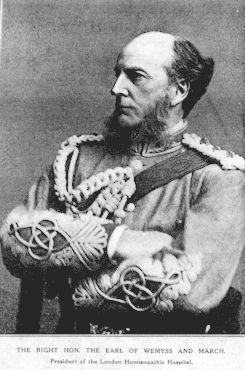Francis Richard Charteris 10th Earl of Wemyss Lord Elcho 1818 - 1914
August 15, 2008
 Francis Richard
Charteris
**10th Earl of Wemyss**
GCVO 1818 – 1914
known between 1853 and 1883 as Lord Elcho, was a British
Whig
politician.
Francis Richard
Charteris
**10th Earl of Wemyss**
GCVO 1818 – 1914
known between 1853 and 1883 as Lord Elcho, was a British
Whig
politician.
Francis Richard Charteris developed an interest in the alternative
medical practice of
Homeopathy, even becoming
President of the London Homeopathic
Hospital
until his death.
(Artwork lithographed by Vincent Brooks Day & Son. London. From an original caricature by Carlo Pellegrini. Produced for “Vanity Fair” 23rd July 1870).
In 1866, Charteris was on the Management Board of the Association for the Trial of Preventative and Curative Treatment in the Cattle Plague by the Homeopathic Method, with George Thomas Keppel 6th Earl of Albemarle, William Pitt Amherst 2nd Earl Amherst, Henry Charles FitzRoy Somerset 8th Duke of Beaufort, Ralph Buchan, William Alleyne Cecil Lord Burghley 3rd Marquess of Exeter, William Coutts Keppel Viscount Bury 7th Earl of Albemarle, James Key Caird 1st Baronet (Vice Chairman), Colonel Challoner, Francis Richard Charteris, George Grimston Craven 3rd Earl of Craven, Henry William Dashwood 5th Baronet, Patrick Dudgeon, Robert Grosvenor 1st Baron Ebury, Arthur Algernon Capell 6th Earl of Essex, Philip Howard Frere, Richard Grosvenor Earl Grosvenor 2nd Marquess of Westminster, Edward Kerrison, Henry Charles Keith Petty Fitzmaurice 5th Marquess of Lansdowne, Lord Llanover, Colonel Farnaby Lennard, George Loch, Archibald Keppel MacDonald, Arthur de Vere Capell Viscount Malden, John Winston Spencer Churchill 7th Duke of Marlborough (Chairman), Frederick Francis Maude, William Miles, James Moore, Charles Gordon Lennox 5th Duke of Richmond, Charles Marsham 3rd Earl of Romney, Sir Anthony Rothschild, John Villiers Shelley, John Robert Townshend 1st Earl Sydney, Lt. Colonel Charles Towneley, Augustus Henry Vernon, William Warren Vernon,Arthur Richard Wellesley 2nd Duke of Wellington (1807-1884), William Wells,
In 1866, the Treasury placed rooms at Adelphi Terrace at the disposal of John Winston Spencer Churchill 7th Duke of Marlborough, who was the Chairman of the Association for the Trial of Preventative and Curative Treatment in the Cattle Plague by the Homeopathic Method, based on the research done in Belgium by Edward Hamilton, with John Winston Spencer Churchill 7th Duke of Marlborough overseeing the work of Edward Hamilton, George Lennox Moore, James Moore and Alfred Crosby Pope.
William Coutts Keppel Viscount Bury 7th Earl of Albemarle issued an address or report for the Association for the Trial of Preventative and Curative Treatment in the Cattle Plague by the Homeopathic Method in 1866. Bury reported that the Dutch had experienced such success with homeopathy against that cattle plague, that they had authorised Edward Hamilton to visit Holland to investigate this.
Edward Hamilton discovered that the Dutch had treated 4798 cattle, 1031 were destroyed = 3767 were treated (with a mixture of allopathic and homeopathic treatments), the survival rate for the beasts treated was 45%, and the survival rate for the beasts treated only by homeopathy was 72-5%.
The Dutch Government had agreed to allow E Seutin, a homeopathic chemist, the total control of infected cattle in Matterness, and initially, E Seutin saved 70% of the cattle, though latterly, he had saved 9 out of every 10 beasts brought to him for treatment, and E Seutin’s use of homeoprophylaxic treatment of unifected beasts brought the epidemic under control entirely within four weeks. Matterness was pronounced free from infection and it has remained thus ever since. The remedies used were arsenicum, phosphorus, phos ac, rhus tox and sulphur.
In 1866, George Lennox Moore became involved with Association for the Trial of Preventative and Curative Treatment in the Cattle Plague by the Homeopathic Method, alongside Edward Hamilton and Alfred Crosby Pope, and overseen by John Winston Spencer Churchill 7th Duke of Marlborough.
George Lennox Moore wrote a detailed report on these trials, including a refutation of the falsities published in _The Lancet__ _regarding the homeopathic treatment of the cattle plague, attacking William Coutts Keppel Viscount Bury 7th Earl of Albemarle and accusing him of ‘being completely misinformed on this matter‘, and inventing a trail of misleading mistruths about the situation.
The orthodox statistics of this clinical trial revealed 8640 cases, 8% killed, 77% died and 15% recovered, though John Winston Spencer Churchill 7th Duke of Marlborough subsequently issued the interim homeopathic results claiming up to 50% recovery rates with arsenicum, belladonna, phosphorus, rhus tox and turpentine as the main homeopathic remedies used.
The final report on the homeopathic trials in the treatment of cattle plague was issued by John Winston Spencer Churchill 7th Duke of Marlborough. The orthodox statistics of this clinical trial revealed 8640 cases, 8% killed, 77% died and 15% recovered, though John Winston Spencer Churchill 7th Duke of Marlborough subsequently issued the interim homeopathic results claiming up to 50% recovery rates with arsenicum, belladonna, phosphorus, rhus tox and turpentine as the main homeopathic remedies used.
‘His Lordship, who was 96 on his last birthday wrote with his own hand, under date March 12, 1914: “I wish all success to Homeopathy, to which I attach my physical well-being in a great measure. When I was 90 I was asked to what I attributed my well-being at that late period of life.
My answer was ‘To parentage and moderation.’ I should have added ‘AND HOMEOPATHY.’ with which I have been treated since I was 20.” [The Right Hon. The Earl of Wemyss and March, President of the London Homeopathic Hospital).
Francis Richard Charteris befriended Mary Augusta Ward by arranging for a homeopathic remedy to be sent to her sick child. They remained friends for many years as a result.
Francis Richard Charteris was an active supporter of homeopathy his whole life. Charteris assisted helpful legislation through Parliament (as in 1858):
In America, Francis Richard Charteris advocated veterinary homeopathy and his wife was also active in support of homeopathy.